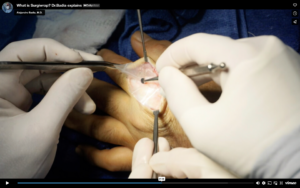
Adhesion barrier film after a capsulectomy. The adhesion barrier used on this patient is surgiwrap by Mast biosurgery.
"The tendon is so scarred that once we release that, the scar is going to reform & we want to create a barrier between the skin & the tendon” - Dr. Badia
An adhesion barrier film used in orthopedics is a medical product designed to prevent the formation of adhesions or scar tissue in and around surgical sites. Adhesions are abnormal bands of fibrous tissue that can develop between internal body structures after surgery or injury. In orthopedics, these barriers serve several important purposes:
Preventing Adhesions: The primary purpose of an adhesion barrier film is to prevent the formation of adhesions. When orthopedic surgeries involve manipulation of tendons, ligaments, muscles, or other soft tissues, there’s a risk that these tissues can adhere to each other or to nearby structures during the healing process. Adhesion barriers act as physical barriers to separate tissues, reducing the likelihood of adhesion formation.
Maintaining Joint Mobility: In procedures involving joints, such as arthroscopic surgeries or joint replacement surgeries, adhesion barriers help maintain joint mobility. By preventing adhesions, they ensure that joint structures can move freely, which is crucial for post-surgical function and range of motion.
Pain Reduction: Adhesions can cause pain and discomfort as they restrict the movement of tissues. Using an adhesion barrier can help reduce post-operative pain by minimizing the formation of these restrictive tissue bands.
Facilitating Healing: By preventing adhesions, these barriers can create a more conducive environment for healing. Tissues can heal without being hindered by scar tissue, allowing for better functional outcomes.
Minimizing Re-Operation: In some cases, adhesions can cause complications that require additional surgeries to correct. Using an adhesion barrier film can help minimize the need for re-operations by reducing the risk of adhesion-related complications.
Enhancing Surgical Precision: Surgeons often use adhesion barriers during complex orthopedic procedures to improve their ability to work precisely. By providing a clear boundary between tissues, these barriers can aid surgeons in performing delicate maneuvers without unintentional tissue adhesions.

Monday- Friday: 8:30AM- 5:00 PM
Saturday- Sunday: Closed